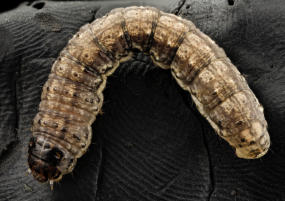
Cutworm



Ultralawn Incorporated
1055 East 260th Street
Euclid, OH 44132
216.731.7756
440.951.3738
Office hours Monday-Friday 9-3 call today with any questions

Cutworms can be destructive insects on maintained turf areas. Damage can occur any time from late May
through the rest of the growing season. Damage is usually most obvious
in June through August, when temperatures are highest and cool season
grasses are not growing vigorously. Damaged spots can persist for
several days.
Description: There are several species of cutworms, which attack turf
grasses. The adults are dull colored moths with a wingspan of one to two
inches. The front wings have distinct scale patterns (faint lines, circles and
kidney-shaped spots), which can be used to identify species. The
caterpillars (the stage that actually damages turf grass) reach 2 inches in
length. Most species have a background color of dull gray or brown but usually have some stripes of brighter or
sometimes darker colors.
Life Cycle: Each cutworm species has its own life cycle, but most cannot survive the local winters. Adults migrate
south in the fall and return on weather fronts in the spring. When the adults return, they begin to lay eggs on
the tips of grass blades. Tiny caterpillars only 1/32 inch long hatch and begin to feed on the foliage. Caterpillars
go through six or seven molts during their development. As they grow, they gradually move deeper into the
thatch, carving burrows, which they line with green excrement. Some large caterpillars stick their heads out of
their burrows at night, chop off grass plants, which are within reach, and pull the blades back into the burrow for
subsequent feeding. After feeding for two to four weeks, the caterpillars transform in the soil to pupae, which
are relatively smooth torpedo-shaped and brown.
Damage: Cutworms feed on several kinds of grasses. They seem to be most apparent in turf areas maintained
at very low mowing heights. Cutworm damage on turf looks like small pockmarks. Closer examination reveals a
small burrow and several grass plants around the perimeter of the burrow, which have been sheared off near
ground level. Often these burrows are lined with green, pellet-like matter. This is caterpillar "frass," or
excrement.
Detection: Cutworm moths and caterpillars are nocturnal, so normal daytime inspections will not unveil the
insects. Visual inspection can give an indication of the presence of caterpillars. Take a close look at suspicious
looking pockmarks and look for sheared grass plants on the perimeter.
Control: Cutworms are relatively susceptible to several turf insecticides. The key to successful control is to apply
an insecticide when most of the caterpillars are still very small, if possible. The insecticide should be watered in
lightly, just enough to move the insecticide off the blades and into the upper thatch. The area should not be
mowed for one or two days after application.



















